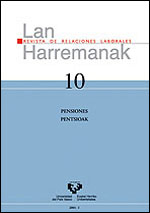Buscando la estabilidad para la empresa y el empleado: cómo construir modelos mixtos de previsión que optimicen las aportaciones empresariales: los Cash Balance Plans
##plugins.themes.bootstrap3.article.main##
##plugins.themes.bootstrap3.article.sidebar##
Abstract
The situation as regards supplementary social welfare provisions has changed in various ways in countries with more experience of such systems than Spain. For years now, we have been witnessing an in-depth consideration of the pros and cons of the different systems, and we now seem to be going back to the origins of welfare: employers provide certain amounts and employees aspire to obtain benefits that cover a minimum objective and are at the same time relatively stable. It is interesting to see therefore how in most countries the trend is not towards pure defined contributions, but rather towards mixed models that determine costs to employers and stabilise benefits for employees. It is important to learn how others have dealt with problems and to apply that lesson to the problems we find in our own case. In our opinion, we must present the advantages that stable models can provide for groups of employees in a company and try to stop merely repeating clichés which are simplistic and not entirely correct. That is what this paper aims to do.
How to Cite
##plugins.themes.bootstrap3.article.details##
Authors who publish in the journal "Lan Harremanak" do so in agreement with the following terms:
1. Authors retain the copyright of their papers. while ceding to the journal "Lan Harremanak" the right to the first publication of their article.
2. The publisher UPV/EHU Press is a joint copyright holder, in order to protect the legitimate use of the published paper and compliance with CC terms.
3. Published papers are subject to a Creative Commons CC-BY license (unless stated otherwise) which permits third parties to share the paper, on the condition that the author and source are specified when material is reproduced.
4. Authors can enter into other non-exclusive license agreements regarding the published version of their work (e.g. depositing it in an institutional repository or re-publishing it as a monographic volume), providing the author and source are given appropriate credit.
5. Dissemination of submitted articles via Internet is both allowed and recommended (e.g. in institutional repositories and/or on the researcher's web page), both before and during the process of submission, since this can lead to interesting dialogues and also increase citations to the eventual publication.

